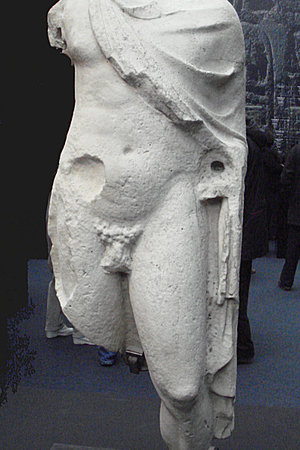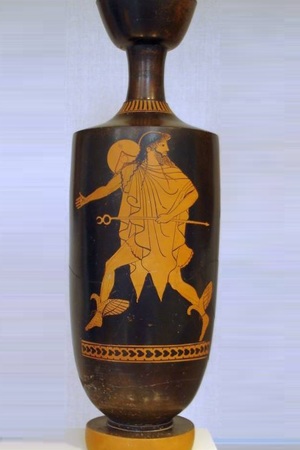Chlamys
Chlamys, also known as chlamis (Ancient Greek: χλαμύς), was an outer garment worn by ancient Greeks. It was made of woolen fabric and differed from the rectangular himation in terms of size, cut, and method of wearing. The chlamys was an elongated cloak that was draped over the shoulders with the shorter side worn at the neck and fastened with a fibula on the chest or right shoulder.
Originally, the chlamys was considered a garment worn in northern Greece (Thessaly and Macedonia), but later it became widespread. The Spartans and Athenian ephebes (young boys up to the age of 20) wore the chlamys, as did hunters, travelers, horse riders, and soldiers throughout the Greek states. Chlamydes were made from various types of fabric, solid-colored or patterned, and adorned with diverse motifs and designs. For example, the chlamys of the ephebes was yellow or saffron-colored, while soldiers wore red chlamys, and actors' chlamys were embroidered with gold.
Later, the chlamys influenced Roman fashion and transformed into sagum and paludamentum.
Related topics
Ancient Greece, Hoplite, Sagum, Paludamentum, Himation
Literature
- Amelung W. Χλαμύς // RE. Bd. III, 1. Stuttgart, 1899. Sp. 2342-2346
- Bieber M. Griechische Kleidung. Berlin, 1928
- Bieber M. Entwicklungsgeschichte der griechischen Tracht. 2. Aufl. Berlin, 1967
- Pekridou-Gorecki A. Mode im antiken Griechenland: Textile Fertigung und Kleidung. München, 1989
- Women’s Dress in the Ancient Greek World / Ed. by L. Llewellyn-Jones. London, 2002
- The Clothed Body in the Ancient World / Ed. by L. Cleland et al. Oxford, 2005
- Lee M. M. Body, Dress, and Identity in Ancient Greece. Cambridge, 2015




